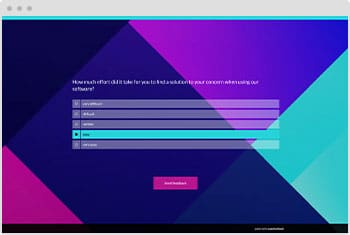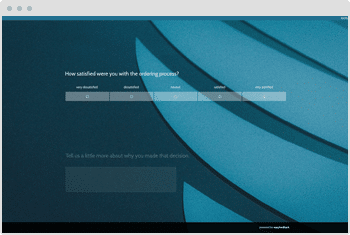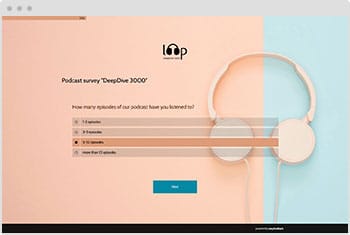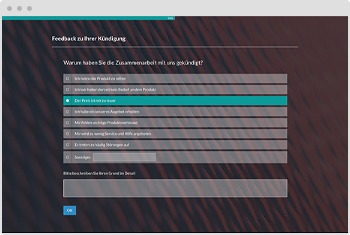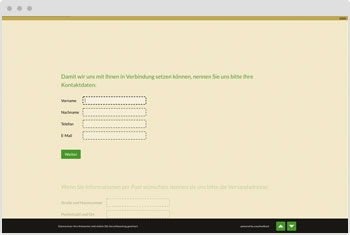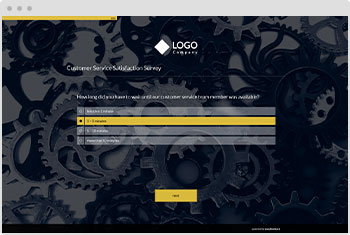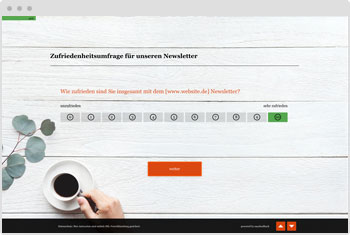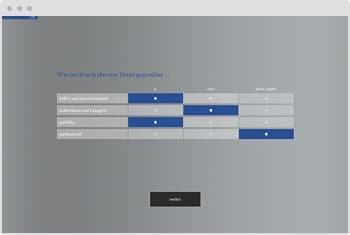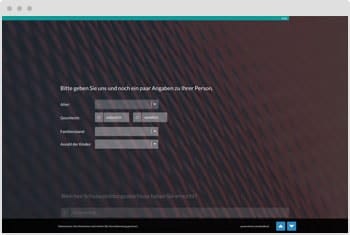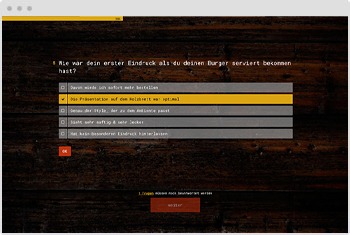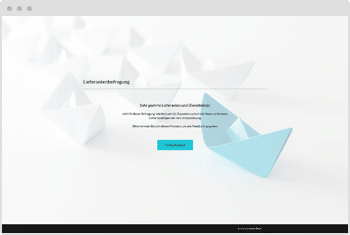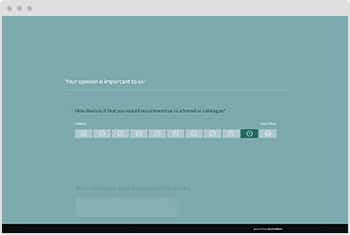Create great customer surveys
Free templates, expert tips & real-time results – with easyfeedback you create GDPR-compliant customer surveys and gain important insights.


Thousands of companies have already created surveys with easyfeedback. And more companies are joining every day
Why conduct customer surveys?
Satisfied customers are loyal and therefore returning customers who increase your sales. With customer surveys, you can measure satisfaction along the entire customer journey and improve the customer experience at every touchpoint. Learn your customers’ needs and wants and offer an optimized experience and products.

Collect customer feedback
Collect valuable real-time feedback at various touchpoints along the entire customer journey. This means you’re always up to date and can identify new trends and opportunities early on – whether by email, QR code, social media or website integration.

Identify customer needs
Feedback from customer surveys can help you learn your customers’ needs. Tailor your offerings to exactly what your customers want, or find out what’s preventing interested parties from becoming customers with you.

Exploit optimization potential
When you know your customers’ needs, you can also proactively make improvements. Don’t leave opportunities to develop the best possible offering. By doing so, everyone will have a great experience with your products and services.

Recognize customer satisfaction
Put customer satisfaction first. Find out what your customers think about your business, how satisfied they are with your products and services, how they rate you compared to your competitors, and more. With feedback from customer surveys, the sky’s the limit.

Strengthen customer loyalty
Satisfied customers also increase your customer retention and loyalty in the long run. And loyal customers tend to return to you. It’s not a novelty, yet it’s still relevant: keeping a customer is considerably cheaper than acquiring new ones. So always nurture the relationship with your customers.

Accelerate sales growth
Word of good products and services gets around. Attract promoters who recommend your business and then increase sales with recurring purchases and cross-selling opportunities.
Highlights of the easyfeedback survey software
Invitation options
Use invitation options like website integrations, social media, email, QR code and many more to best reach your customers. And thanks to responsive design, each survey automatically adapts to the device and provides a great experience.

Corporate design
Adapt the logo, colors, fonts and images of your customer survey to your company’s corporate design with a click. This allows you to perfectly showcase your company’s brand in the survey.

Reporting
Identify customer groups based on response behavior and learn more about their needs – individually or in direct comparison to other customer groups. Create meaningful comparisons at the click of a button and present them in your own reports.

Data protection
As a German provider of customer surveys, easyfeedback consistently relies on data protection in accordance with GDPR: server location in Germany (ISO27001), trained employees, data protection officer and other security measures.

Create a competitive advantage with an exceptional customer experience

Customer experience
Almost every successful company recognizes that today’s marketplace is defined by the customer experience. Organizations dedicated to this principle are as diverse as eCommerce, automotive retailers, or the movie industry.
The customer experience a company wants to deliver in this regard can vary widely. That’s why it helps to understand what your customers’ basic wants and needs are. This will help you determine what a great experience should look like for your customers.
Collecting and segmenting data are classic starting points for understanding your customers. But simple data is not enough. Successful customer experience measures apply a human filter to the data they collect to ask overarching questions and gain deeper insights. Who exactly are my customers as individuals? What motivates them? And what are the root causes of their satisfaction?
Put your customers first and tailor your company’s services to their needs through customer surveys. In this way, you will not only increase the customer experience (CX), but also customer satisfaction.
Customer contact
With a contact form, you give your website visitors the opportunity to get in touch with you quickly and easily in case of questions or problems. By now, this is an important customer touchpoint when it comes to customer surveys. But many contact forms on websites still have the classic form style and seem daunting.
Give your contact form a modern design with an online questionnaire. These can be easily and seamlessly added via various website integrations. Button, feedback tab, popup or focus layer? You are spoilt for choice.
Customer service
By soliciting feedback from your new customers and prospects, you gain insight into what’s working well with your product or service and what actions are needed to improve the experience. It also shows your customers that you value their opinions and incorporate them into the design of your offering. Your customers feel more connected to the company, which can help you gain important brand ambassadors.
You can collect and analyze this feedback in a variety of ways at different points along the entire customer journey. Whether you want to improve the quality of your customer service, the services your company offers, or the user experience on your website.
Check how your customers’ customer experience is with customer surveys at regular intervals to ensure a great experience. You can always use our templates and samples for this purpose.
Market Research & optimization
The analysis on market needs of new and potential customers and the evaluation of opportunities is the starting shot of every successful idea. With primary research through customer surveys, you can get these needs in the form of feedback. Use this feedback to understand the potential of your product even before you invest in it.
Want to go to market with the right price for the product or uncover user behavior to learn more about your customers’ experience with the product? You can also design the perfect product and pricing model by using feedback from your prospects.
Easily explore product satisfaction and loyalty to discover improvements for the next generation. By doing so, you’ll delight your customers and create an exceptional customer experience. From the first idea to the next generation of products, the right questions can tell you everything.
Net Promoter Score
To improve customer loyalty, you need to know your customers’ buying decisions and what they expect from your products and services. This will enable you to proactively make improvements and satisfy your customers. After all, satisfied customers are returning customers.
That means you have more cross-selling opportunities. And your satisfied customers will be willing to actively recommend your company to others. You can find out by asking for the Net Promoter Score®. The NPS is the most widely used method for measuring customer loyalty. This makes it an internationally measurable metric that you can use to compare yourself with your competitors.

Choose the right plan for your customer survey
The easyfeedback plans are ideal for companies of all sizes. A one-time customer survey can already be carried out in the Starter or Single plan.
For those who want to compare results and customer segments, the Business plan is ideal. And for companies that want to work with several departments, the Company plan offers the best option for working autonomously in different teams.

Lead generation on the website
Ever thought of leading the website visitor to the right product with short questions? Here is the solution. Through a small questionnaire, the needs are determined and the visitor is led directly to his desired product, if he has previously entered his email address.
Related articles about Customer Experience
Almost everything you need to know about customer surveys
1. What does customer survey mean and what is it used for?
The customer survey serves primarily to measure customer satisfaction, customer loyalty and their causes. Ideally, customer surveys should be carried out regularly and identify starting points for increasing satisfaction and loyalty. At the same time, the customer survey is also a means of increasing customer satisfaction, since the mere fact that the company inquires about satisfaction increases customer satisfaction.
2. What methods are available for conducting a customer survey
How and where can I place my customer survey?
The choice of method is extremely important in order to reach your previously defined target group in the best possible way. The goal of the customer survey is what counts. If you have a customer base with an existing email list, it is particularly worthwhile to invite them directly by email to your customer survey. The personal contact is already established and both parties know each other.
You may even be able to address each customer in a personalised way, which will additionally strengthen the bond. There are many examples of customer surveys of this kind – you will certainly know it: “How satisfied were you with your purchase?” or “Please rate your experience with our product”. This method provides you with regular customer feedback, with which new measures can be planned.
If it concerns website visitors, interested parties and potential buyers, embedding the survey in the website is a suitable method. Here, too, the goal of the customer survey is always important. However, with this method it is worthwhile to use a few questions in order to receive quick and concise feedback. “How do you like this article?”. The integration of the customer survey can be done for example via button, feedback tab, popup or focus layer and can thus be seamlessly integrated into your website.
Would you perhaps even like to actively seek personal contact with your customers and exchange ideas with them? Here it is worthwhile to use social media and place the web link there. You can achieve particularly high participation rates via social media, as this is where your company’s “fanbase” often accumulates. Customers who follow you on Facebook, LinkedIn & Co. are most likely to be enthusiastic about your company and want to be part of the development and always up to date.
The bond between your company, product or service and customers who follow you on social media is usually much closer than with customers who don’t. This increases the chances of participating in the customer survey, which gives you more relevant feedback.
However, these are just a few popular of the many methods of conducting a customer survey. Be creative in your choice of method and use the full range. A web link can be placed not only in emails or social media, but also in PDFs. And even a QR code can be used to refer to one of your customer surveys. Ask your customers at all relevant touchpoints for feedback on your experience to provide the best possible customer experience.
3. How should I evaluate and analyze my customer survey?
The evaluation or analysis of the data for a customer survey is a major hurdle for many people. It is difficult to make a general statement when evaluating the data because the evaluation of the customer survey depends to a large extent on the type of questions and the selected answer format.
Imagine the following scenario: When asked about customer loyalty to your company, the NPS query gives you a value of 52 (on a scale of -100 to 100). According to the benchmarks, this means that you can make a general statement that the customer loyalty in your company is very good. However, what you now lack is the knowledge of which customers are more strongly bound to your company than others. At first you can’t do much with the number 52 and don’t know which areas work particularly well or in which areas improvements are necessary.
But if you know which age groups have a particularly close relationship with your product, service or company and which do not, you can target these groups. This is the point where it becomes interesting and informative within your evaluation. There are various methods of segmenting these into different groups. But what exactly does customer segmentation mean?
In customer segmentation, individual groups are identified from the entirety of (potential) customers, where the individuals within this group have the same characteristics. The assumption here is that these groups usually also show the same (buying) behaviour, but differ significantly in their behaviour from other groups with other characteristics. These can be groups such as new and existing customers, the age or gender of the target group surveyed (demographic segmentation), the place of residence (geographical segmentation) or certain interests. Segmentation strategies can vary greatly for different companies and industries.
Let us assume that you sell surfboards. Geographic segmentation could reveal that people who live near beaches with swell perceive surfboards differently than people who live in a city far from the water. Demographic segments such as women, men and children are also likely to have different preferences when choosing a surfboard.
As you can see, by segmenting your customers when evaluating your customer survey, you can take a much more customer-oriented approach and identify possible optimization potential for specific groups.
4. Do I have to create a cover letter for each customer survey?
Does a cover letter have to be sent for each survey? The answer to this question is very situation-dependent. However, it is advisable to use a cover letter for some of your customer surveys to introduce the customer to your project thematically first.
It is also advantageous to familiarise him or her with the presumed duration of the customer survey. You should always be honest. If you promise the customer a processing time of one minute and the participant concerned is still on page one of eight after five minutes, then the customer will most likely abandon the customer survey and leave no evaluable feedback.
You should also give your participants a small incentive in your cover letter to participate in your customer survey. This may simply be the prospect of you attaching great importance to the feedback and opinion of your customers and want to constantly improve your offer for them. Many customers are happy about such an undertaking. The mere fact that you want to constantly improve your offer and include the opinion of your customers already increases customer satisfaction.
It is of course also possible to offer a “goodie” in return for customer feedback – this could be a discount for the next purchase, a free additional service or a small gift. However, there are also situations in which a cover letter seems out of place and does not achieve the desired effect. These include, above all, customer surveys where concise feedback is needed.
In these cases, reading the letter would probably take longer than answering the customer survey itself. An example of a type of this type of survey is collecting feedback on an article on your website or the website itself: How do you like this blog article? How do you rate the usability of our website?
Questions like these from the example can usually be answered within seconds and with a star rating and do not require a (detailed) cover letter.
The success of your customer survey is largely determined by the right approach. So think carefully about the purpose for which you want to use your survey and adapt the cover letter to the situation.
5. How do I create the optimal questionnaire for my customer survey?
In order to design the optimal questionnaire for your customer survey, several factors have to be considered. There is no optimal questionnaire for every case, because every case has different requirements and goals. At this point a very important key point comes into play again: the goal. Never lose sight of this when creating the questionnaire.
Would you like to know how comprehensive or limited your customers’ assessment of the product selection on your website is? Then ask for exactly that. Avoid unclear and imprecise questions at all costs in order to leave no room for interpretation. The longer the participant has to deal with the questions, the higher the probability that sooner or later he or she will stop participating.
In order to design the questionnaire as optimally as possible, also keep the texts and questions to be read as short as possible and concentrate on the essential. For example, explaining a question for too long can lead to it being misunderstood or not understood at all. And to prevent your participants from getting bored, avoid monotonous or uniformly consecutive questions with the same content. In this way you keep the drop-out rates as low as possible. Asking questions is not difficult, but asking good questions is an art.
The length of the questionnaire is one of the most important factors when designing the questionnaire. This should always depend on the degree of customer loyalty or the loyalty to your participants. As a rule of thumb one can say: The higher the loyalty, the more questions can be asked.
If the level of loyalty is low, you should therefore avoid asking more than 10 questions or venturing into complex matrices. The necessary effort – especially with a matrix question – is always underestimated. Put yourself in the participant’s perspective. Would you answer the customer survey under the same conditions? Why should he fill it out and invest his precious time? But always try to keep it as short as possible, regardless of the degree of commitment to your participants. Time is an important factor and the attention of your participants is a gift.
To reduce the drop-out rate even further, it helps to design your customer survey in an appealing way. Does the appearance of the company or the product range come across in the questionnaire? Your own branding can already make a big difference.





